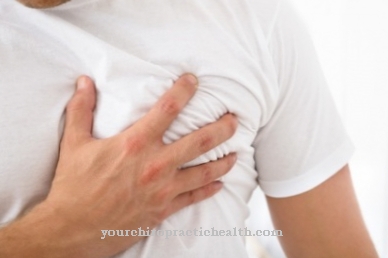Chest pain (chest pain when breathing) are among the complaints that are frequently complained about and can be the expression of various diseases. By no means is this pain always a sign of lung disease, as most lay people mistakenly assume.
causes

If the symptoms do not increase significantly during coughing and deep breathing, the observation speaks against the pleura being involved.Chest pain is very often just an accompanying symptom of an infectious disease, for example the flu, measles, scarlet fever, rubella, or an expression of rheumatism. The cause of the pain in the chest area in these cases is a circumscribed and more or less extensive inflammation of the intercostal muscles and the other muscles surrounding the chest, but not the lungs.
Chest pain, especially in the area of the left side of the chest, does not have to originate from the respiratory organs, but can be a sign of a circulatory disorder of the heart muscle, especially if there are simultaneous complaints in the left arm. In general, due to peculiar nerve relationships, the pain is often expressed less in the really diseased organ than in very specific parts of the body.
This is characterized by pain in the area of the right shoulder blade in diseases of the gallbladder. Shingles, for example, can begin with very characteristic, very severe symptoms in one side of the chest before any skin symptoms appear, which can often be interpreted as pleurisy by the non-specialist, while in reality the intercostal nerves are irritated.
Chest contusion
Symptoms after chest contusions are particularly intense and often very persistent. The symptoms increase with deep breathing and can cause sharp pain, especially when coughing. Here, too, the cause is not an injury to the lungs, but rather a broken rib, irritation of the periosteum or ribs, or circumscribed bleeding in the muscles.
Pelvic inflammation
Diseases of the pleura and lungs, especially the so-called dry pleurisy, are characterized by violent pain that intensifies with deep breathing, which noticeably subside in the pause that occurs between exhalation and inhalation. This leads to exudation and deposition of fibrin. Through this process, the normally mirror-like pleura and lungs are transformed into a rough, uneven surface in a circumscribed area, the friction of which the doctor can feel with the hand placed on it. If, on the other hand, in the course of dry pleurisy, for whatever reason, there is a greater exudation of tissue water, then one speaks of wet pleurisy.
It is sometimes particularly difficult to recognize the disease if the part of the pleura that covers the diaphragm is affected, because the examining doctor often cannot detect anything abnormal and only an X-ray examination shows that the diaphragm is poorly mobile, which explains the cause of the disease becomes. How complicated the situation sometimes is can also be seen from the fact that there are, albeit rarely, congenital or acquired gaps in the diaphragm through which, for example, part of the gastrointestinal tract can be shifted into the chest cavity. Here, stronger complaints are indicated when the abdominal press is tensed, but the symptoms of laypeople relate to the chest organs.
You can find your medication here
➔ Medication for chest painLung diseases
Diseases of the lungs, for example pneumonia, widening of the small branches of the trachea (bronchiectasis), larger cavities (abscesses), bronchial asthma and chronic bronchitis, very often result in more or less large amounts of sputum and slightly excessive to high temperatures (fever).
Depending on whether the inflammatory processes take place in the immediate vicinity of the pleura, it can also lead to sharp pain when breathing and coughing. Usually, however, these pains are not the main focus.
In contrast, pulmonary tuberculosis often begins without any alarming symptoms. Except for a moderate exhaustion and general fatigue, which may be associated with night sweats, it almost never causes symptoms.
Even the doctor can only capture them with the X-ray procedure or computed tomography, since no or only very minor changes can be detected when tapping and listening to the lungs.
In summary, it can be said that the stabbing pain when breathing is not peculiar to a disease, but can be an expression of the most diverse pathological changes in the chest or upper abdominal area. Often, however, disorders of the spine can also pull painfully into the chest region.
In any case, it is advisable to consult a doctor if the symptoms are more severe. Unfortunately, all more serious illnesses, including lung cancer, which has recently become common, are usually pain-free at the beginning. It is therefore urgently necessary, in your own interests and those of others, to have preventive examinations carried out by a doctor more often.
Diseases with this symptom
- Angina pectoris
- Lung cancer
- COPD
- lung infection
- bronchial asthma
- Mediastinitis
- pleurisy
- Vertebral blockage
- Bronchiectasis
- flu
- Bruised ribs
- Broken rib
- Chronic bronchitis
- Diaphragmitis
- tuberculosis
Complications
Pain when breathing is usually a side effect of relatively harmless illnesses, but it can also lead to serious complications. If the pain occurs as a result of pneumonia, it can be assumed that the symptoms will intensify. In addition, it can lead to bloody discharge and further inflammation in the area of the lungs and throat.
Pain when breathing, which occurs as a result of a broken rib or a bruise, also initially intensifies, but usually decreases again during the course of recovery. This is different with pain as a result of a flu-like infection. In this case, the pain when breathing is accompanied by a variety of complications. There is pain in the entire throat area, the familiar flu symptoms such as runny nose and cough and a physical discomfort. With scarlet fever, rubella, measles or chickenpox as well as rheumatic diseases, there is sometimes severe pain when breathing.
Likewise with circulatory disorders, whereby the complications in this case depend on the respective underlying disease and can vary widely. Possible complications are myocardial infarction, an enlargement of the pain center, weak breathing, circulatory problems and the associated impairment of the patient's quality of life. If the painful breathing is the result of an accident, there may be an injury to the lungs that was not adequately treated. Bleeding, inflammation, and periosteum irritation are possible complications.
Outlook & forecast
Chest pain and painful breathing are to be taken seriously. Coughing and severe lung disease can manifest as chest pain and painful breathing. In order for the prognosis for a cure to be good, it is important that the person concerned becomes aware of the symptoms quickly and that they contact a doctor.
If there is a lung disease, a further examination by a lung specialist is necessary, as he can make an accurate and detailed diagnosis. You can also do something yourself for healing and improvement. So that the symptoms do not get so bad, it can be helpful if the person affected drinks freshly brewed tea over and over again throughout the day. In this way you can calm the affected areas and the pain can be alleviated.
The prospects for a treatment look very good if you act on time. It also depends on the cause of the chest pain and painful breathing. Without proper treatment, not only can the pain worsen, but the underlying disease can also get worse. If it is a lung disease, you should contact a pulmonologist immediately so that the disease does not develop into a life-threatening situation.
When should you go to the doctor?
There are many possible causes of chest pain and painful breathing. Theoretically, all organs in the chest can be painful. In addition, pain from the abdominal organs occasionally radiates into the chest. If you have chest pain or painful breathing, you should see your doctor immediately as a precaution. Medical laypeople can hardly differentiate between harmless chest pain and painful breathing from possibly even life-threatening diseases.
Chest pain and painful breathing can be a normal symptom of an infectious disease such as a severe cold, flu, scarlet fever, rubella, or measles. Circulatory disorders, inflammation of the intercostal muscles or pleurisy can also lead to chest pain and painful breathing.
Athletes often attribute the phenomenon to chest bruises, which can be true. However, one should also think of a potentially life-threatening disease such as a heart attack or a damaged aorta. Esophageal problems, pneumonia or even lung cancer are further convincing arguments to consult a doctor immediately if you experience chest pain and painful breathing.
Even the family doctor, who has usually known his patient for a long period of time, will be able to assess the situation with regard to chest pain and painful breathing. To deepen the diagnosis, he will be referred to a specialist, for example an internist, cardiologist, gastroenterologist, pulmonologist, orthopedic surgeon or neurologist.
| Dr. med. Nonnenmacher's checklist for your doctor's visit:
➞ Download chest pain checklist Please answer the following questions as comprehensively as possible. Also, write down any additional questions and then ask them to your doctor.
|
You can find your medication here
➔ Medication for chest painDoctors & therapists in your area
You can do that yourself
Some home remedies and self-help measures can help alleviate the discomfort. The ingestion of thyme with food or as tea has an expectorant and anticonvulsant effect. Expectorants containing ivy extract support the important expectoration. Bed rest is important to the recovery process. Taking cough suppressants such as Icelandic moss extract improves the night's sleep. In the case of a dry cough, the combination with agents that simultaneously loosen the mucus and dampen the urge to cough is not beneficial.
Sweating cures through saunas and Kneipp chest wraps are tried and tested home remedies. The chest wrap, coated with a one centimeter thick quark layer on the inside, applied for 30 to 90 minutes, promotes well-being. A well-ventilated room combined with moist room air has an invigorating effect.
If the problem is chronic breathing problems, relaxation and foot reflexology can help. Breathing in and out calmly and evenly strengthens the healing process. Taking medicinal herbs such as rabbit foot plantain and ribwort plantain over smoothies or as a tea infusion improves well-being. If the person concerned drinks at least two liters of water a day, this has a strengthening effect. Vitamin-rich food strengthens the immune system.
For pain caused by bruised ribs, cooling measures with ice packs or gel have a pain-relieving effect. The sufferer supports the process of recovery by avoiding major physical activities.
























.jpg)



